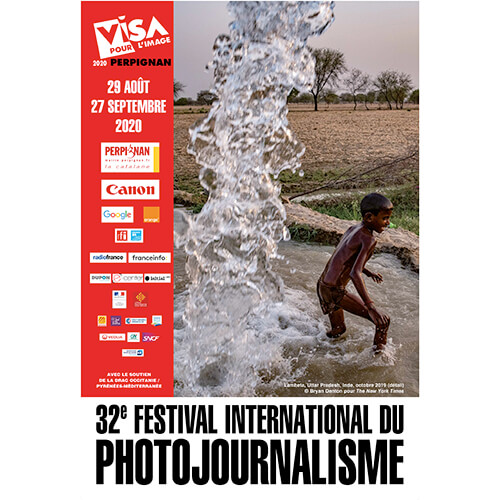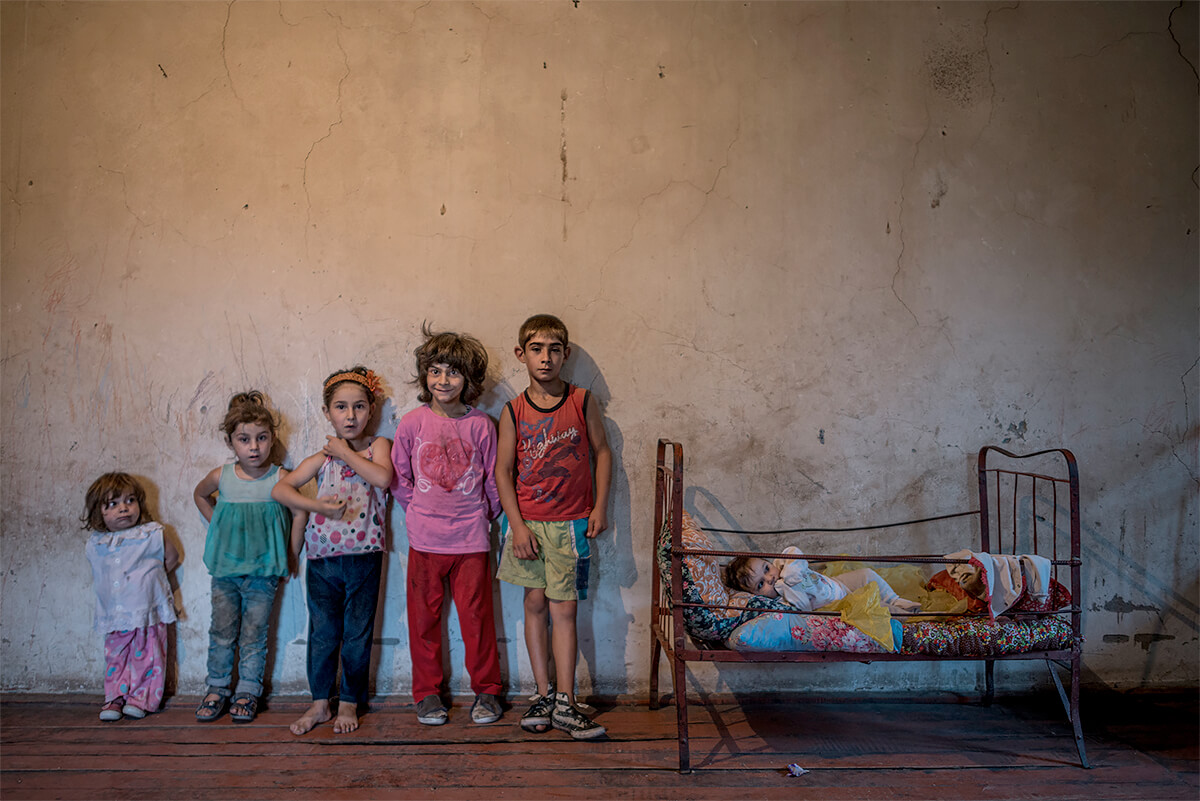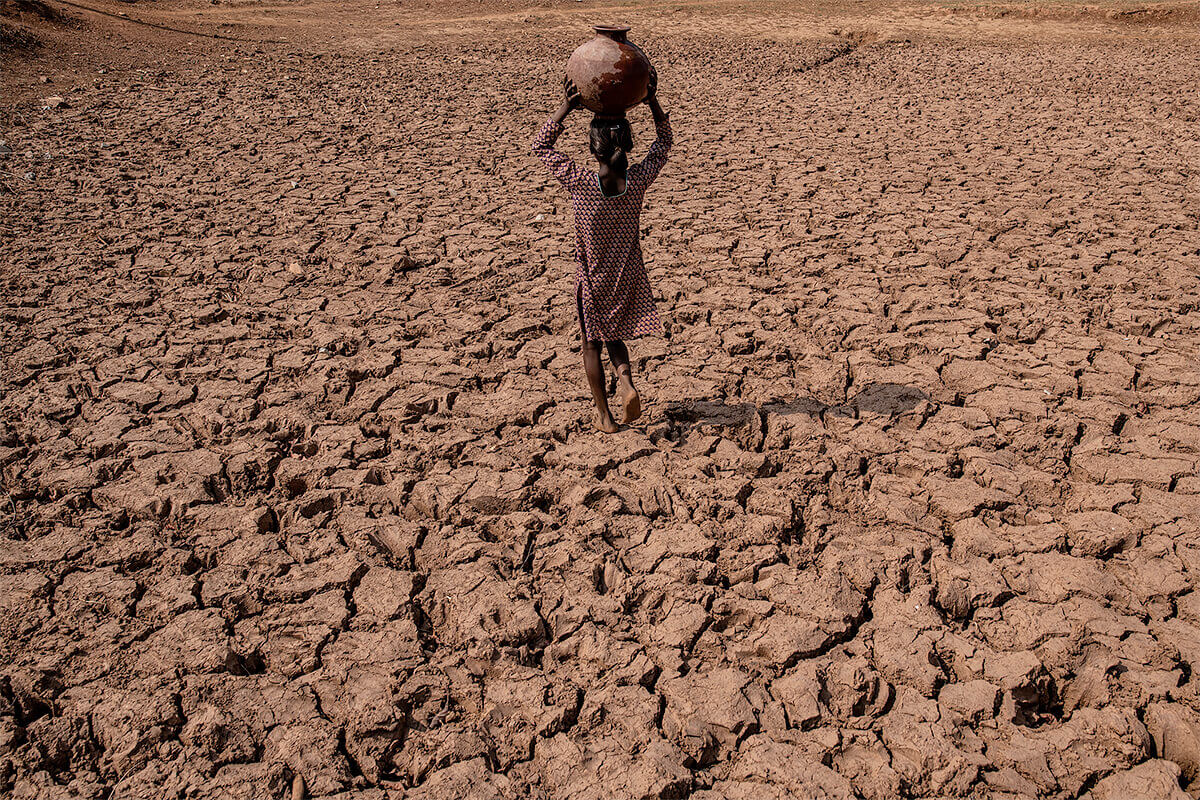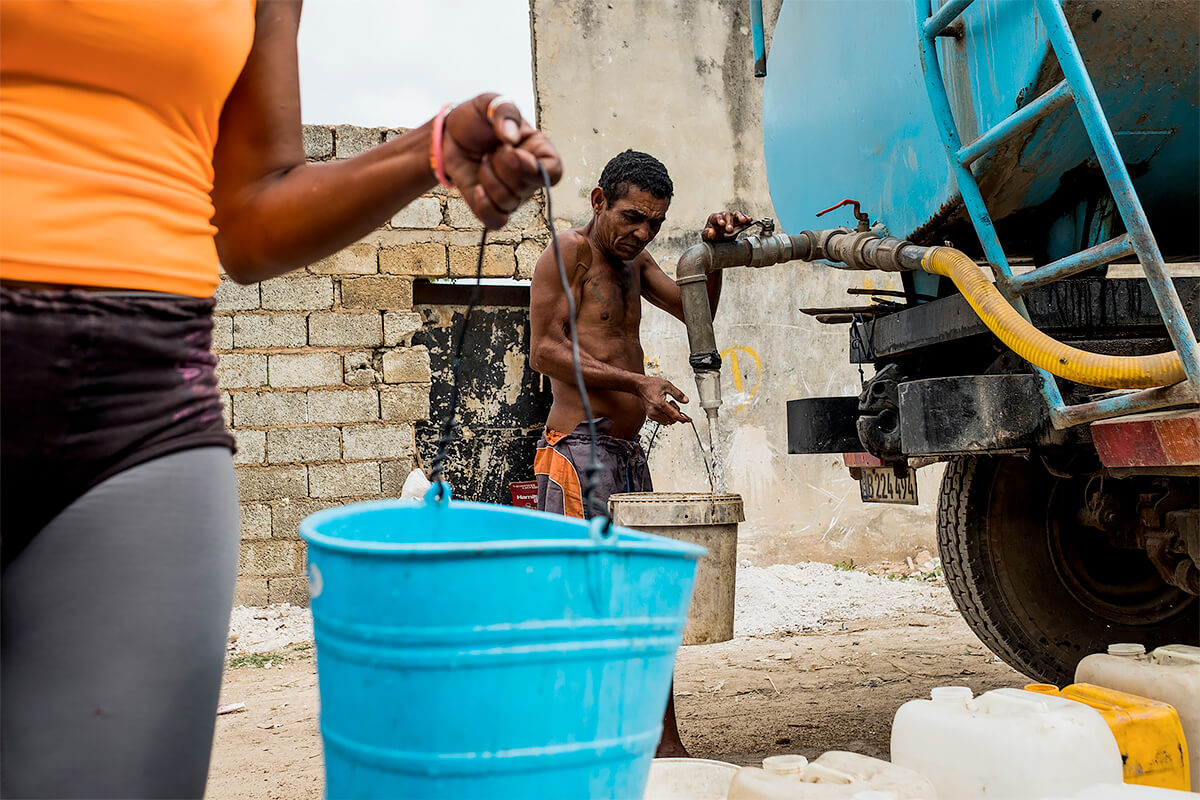Each year, a selection of the best stories from around the world is shown in Perpignan. Here is the list of some exhibitions you will be able to discover this year. You can find the full program on the Visa Pour L'Image website.
Anush Babajanyan: A Troubled Home
VII
Winner of the 2019 Canon Female Photojournalist Grant
For decades there has been conflict in the South Caucasus, in Azerbaijan, in the disputed region of Nagorno-Karabakh, with fighting between Armenian and Azerbaijani forces. In 1994, after six years of war, a ceasefire was concluded, but violence has continued along the contact line between the unrecognized republic of Nagorno-Karabakh*, and Azerbaijan. The ethnic Armenian population in the region receives support from local authorities offering incentives for encouraging large families; for example, a house is given to a family after the birth of the fifth or sixth child. But as the families grow larger, it becomes more difficult for the parents to care for their children. This story follows the experiences of a number of families who, in different circumstances, are all struggling to support their children. In the current economic situation, they endure hardship, affecting living conditions and the development of their children. For many, such hardship has become the norm, but there is always the joy and playfulness of the children. Military presence is clearly felt in Nagorno-Karabakh, and the ambition of protecting the land is related to the goal of population growth. Sons are greatly valued, as can be seen with celebrations at maternity wards when a male child is born. Yet, many of the families I photographed have no fathers. In the village of Charectar, Alisa, the eldest daughter of Epraqsya, a single mother of eight, explained that she wanted to serve in the armed forces, but when I told her of the military academy and female cadets in the capital Stepanakert, Alisa said she would rather stay and work in the village.Children, like adults in Nagorno-Karabakh, know what a struggle is, they know what it feels like, even if they may not be able to put a name to it.
* The republic of Nagorno-Karabakh is not recognized by any of the Member States of the United Nations Organization.
The six children of Varduhi Chobanyan (31), in July 2017, before the family moved to a new house that was being built. Village of Nor Erkej.
Mexico has thirty-two federal states, and many can compete for the title of the most violent state. Guanajuato, Colima, Jalisco, Michoacán, Sonora, Tamaulipas, Veracruz, Chihuahua, and Guerrero are names often cited in reports by international media on increasingly horrific dramas and atrocities. Every superlative could apply to the state of Guerrero, starting with geographical features and weather conditions, on the southwestern coast, where there is the largest opium-poppy growing area in the country, set in natural mountain fortresses surrounding valleys, and protecting criminals. Acapulco, the biggest city in Guerrero state, is part Miami, part Saint-Tropez, and was once a great attraction for the American jet-set with names such as Elizabeth Taylor and Ronald Reagan, but it has lost its glitter, and today it is bullets that are flying. Acapulco is clearly Number 1 in the ranking of Mexico’s most dangerous cities, registering 874 murders in 2018, a record set only to be broken in 2019, and again, no doubt, in 2020. Guerrero is the battlefield for more than forty different groups in a ruthless war for territorial control. There are the cartels, such as the Jalisco New Generation Cartel (CJNG), once the armed wing of the Sinaloa cartel, but now independent; there are conventional criminal organizations and networks, and over recent years, there have been self-defense groups. Communities caught in the crossfire have no faith in corrupt police forces or elected officials with ties to traffickers, so have formed their own armed self-defense militias; but to survive, they often have no other option than to be part of the trafficking. To increase their numbers, some of these rough-and-ready community forces even enroll children, training them to handle weapons. The report, first begun as a personal initiative, was commissioned by Le Figaro Magazine. Alfredo Bosco shows a story of blind violence, of institutionalized violence in a country where, last year, 34,582 people were murdered, focusing on the specific situation in Guerrero, exploring the state which, to all intents and purposes, has been forgotten.
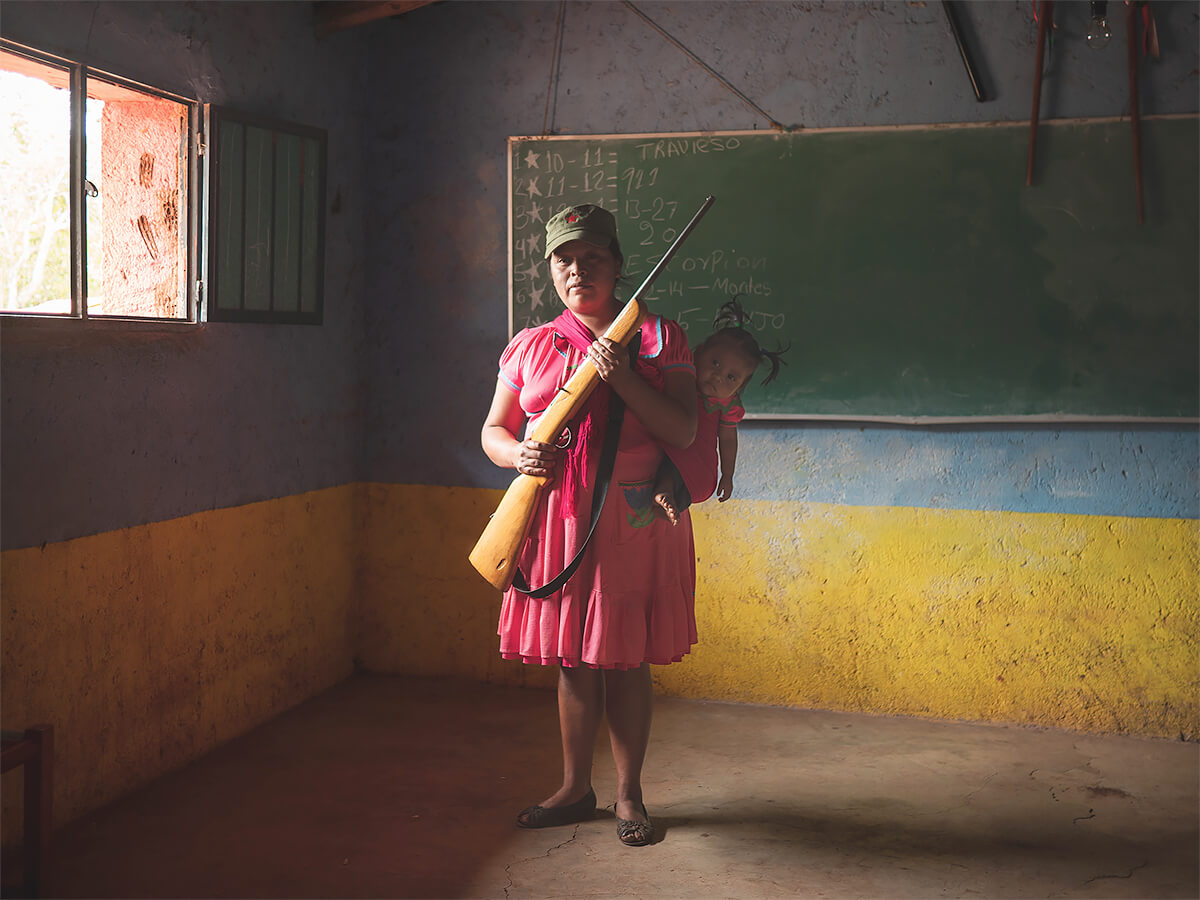
A mother who chose to join the community self-defense force. Since early 2019, the village has been attacked repeatedly by the “Los Ardillos” cartel, forcing residents to take action. Rincon de Chautla, Guerrero, June 10, 2019.
Here is the tale of the final stage before the probable demise of people whose history goes back five thousand years, the tale of their traditions and recollections from the past. The Mohana, also known as the bird people or lords of the sea, are descendants of the first inhabitants of the Indus valley; the remains of the original settlement can be seen at the archeological site of Mohenjo-daro which once stood on the banks of the Indus. Here in the Sindh region of southern Pakistan, a tiny Mohana community still lives in the one remaining floating village on Lake Manchar. What was once a fishing paradise is now contaminated by toxic industrial waste discharged into the waters of the vast lake, as large as an inland sea. My photographs are a record of the end of the paradise on earth where humans and nature have been living in harmony for thousands of years.I have been reporting on Pakistan since 2007, and since 2018 have been spending six months of the year working for extended periods on stories related to threats to the environment. In Pakistan I heard of this extraordinary community and their traditional lifestyle. It was difficult to gain access to these people facing extinction, and special logistical arrangements were needed to reach the remote area. An opportunity arose through Le Figaro Magazine which had already published a story on the bird people in 1992. My goal was to report on and review the situation thirty years on, and to convey the message from these forgotten people.In the Sindh, on Lake Manchar, the encounter with the nomads living in the last floating village had a profound impact on me. Their plight was far worse than I could ever have imagined. Local flora and fauna were being destroyed by toxic industrial waste flowing along a canal and into the lake. The catch that Mohana fishermen once brought in to sell at markets in the region is now only a fraction of what it once was. Dozens of fish species have disappeared, meaning that there are fewer migratory and other birds that follow the Mohana fishing boats. The loss of biodiversity has jeopardized the natural ecological balance.Men, women and children have had to cope with frequent food shortages and dramatic flooding; they have become weaker, often falling victim to malaria and tuberculosis. Having lost the resources that came from fishing, the nomads have often had to abandon their traditional lifestyle on the water in houseboats, and have settled as sedentary communities on the shore, forming villages of shelters made of mud and reeds. I was greatly troubled by the predicament of this unique community facing the all but inevitable prospect of their traditional way of life disappearing. Through my photographs I have aspired to draw attention to the tragedy of the Mohana people, and to elicit a response from local Pakistani policy-makers in a bid to halt this human and environmental crisis. Action must be taken - urgently - if the last of the historic Mohana people are to be saved.
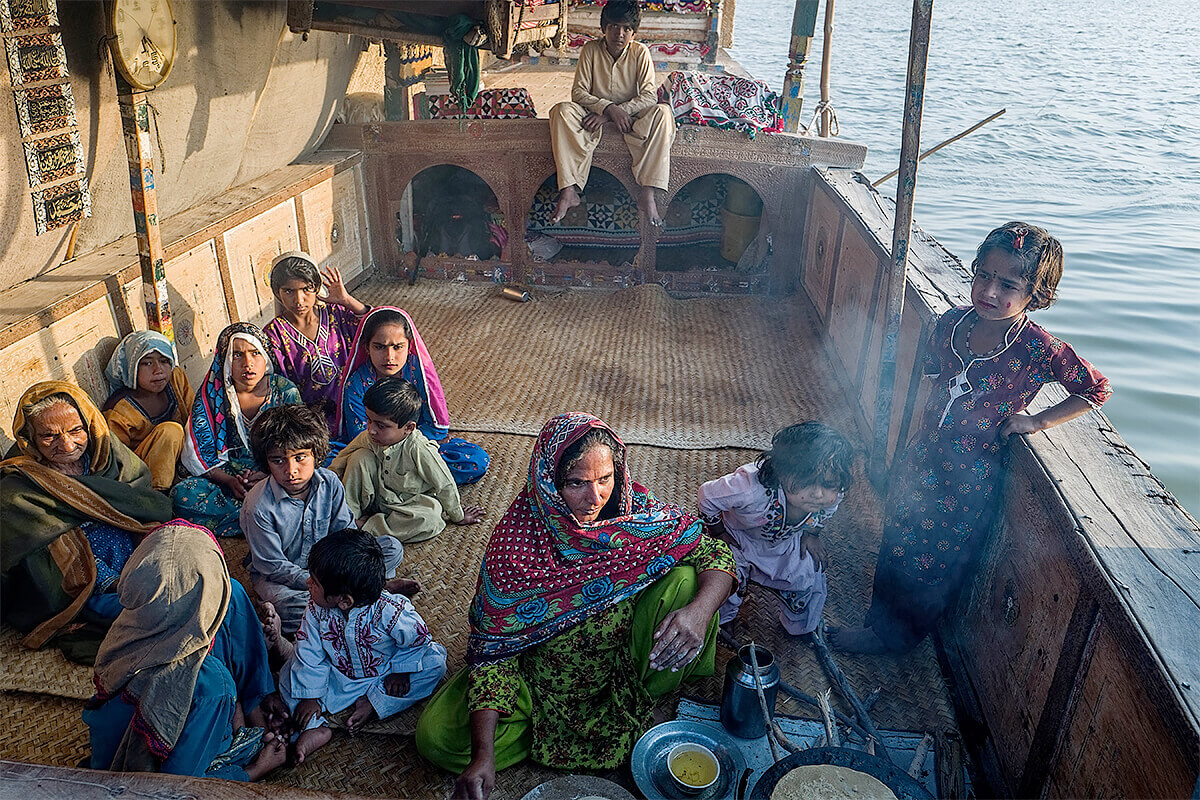
The women are very cautious when cooking on an open fire on deck. If the boat were destroyed, the family would have to live on shore. A new boat would cost one million rupees (US$6,000 dollars).
Augusta-Priolo is one of the largest petrochemical complexes in Europe, covering more than 20 kilometers of the Sicilian coastline along the Ionian Sea, between Augusta Bay and the north of Syracuse, and providing 34% of Italy’s petroleum products.The first industrial development of the site, beginning in 1949, was funded through the Marshall Plan. The bay is deep, there is a plentiful supply of water, and in geopolitical terms, the site is ideally located in the heart of the Mediterranean, with access to cheap labor. These factors attracted development projects, and over a number of years, industrial plants were built, forming a network of refineries, power plants, and production facilities manufacturing asbestos, cement and chemical compounds (e.g. fertilizer and polyethylene), and taking over this stretch of the Sicilian coast. Before long Augusta-Priolo was one of the driving economic forces of Italy, and by the 1980s employed as many as 20,000 people.The intensive industrialization brought rampant pollution damaging the environment, and the situation was made even worse with wheeling and dealing between criminal networks and public authorities, taking advantage of silent and submissive local communities terrified at the prospect of the economy collapsing if the industrial plants closed down.High levels of pollutants have been released into the air, industrial waste has been illegally dumped and buried on land, and toxic sludge and mercury have been discharged into the sea, with an estimated 500 metric tons of mercury dumped in Augusta Bay since 1958. The death rate from breast cancer in the region increased from 8.9% in 1951 to 29.9% in 1980. The prevalence of congenital malformations went from 1.9% in 1989 to 5.6% in 2000, producing the highest rate for abortion and spontaneous abortion in Italy.In 1998, a coastal area of 5,815 hectares and a maritime area of 10,068 hectares were officially recognized by the Italian government as a site of national interest, requiring compulsory decontamination of land, surface water and groundwater. Today, only one small zone has been cleaned up. Emissions of certain substances are still not regulated (e.g. NMHCs, H2S and other VOCs). To make matters worse, a number of decisions have been problematic, for example the decision in 2015 to transfer waste from the iron and steel plant in Tarente to a municipal landfill site.A total of 120,000 residents north of Syracuse, in and around Augusta, Priolo Gargallo and Melilli, have suffered both directly and indirectly from these conditions.Sacrifice is an endeavor to present the human and environmental dramas that have been playing out in the silence of Sicily.
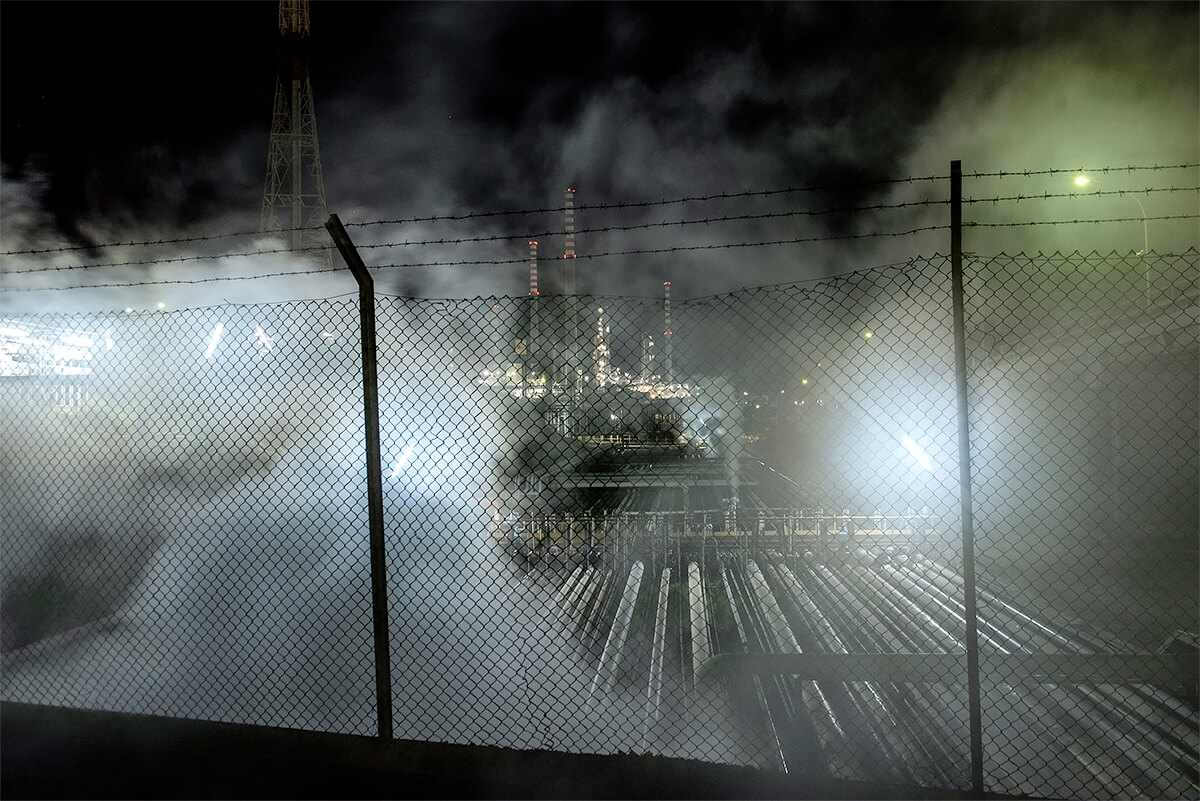
© Elena Chernyshova/ Panos Pictures
The South African-owned Sasol chemical plant. In Italy certain emissions have not been regulated, e.g. non-methane hydrocarbons, hydrogen sulfide, and volatile organic compounds.
Africa is a place that teaches me what I do not know or cannot imagine. When I started living in Kenya, the standards I had as a Japanese person fell apart, one after the other. The concept of time or commitment was different, and it was normal for things not to go as planned. After spending some time here, my standard of expectation was totally altered. However, to compensate for the hardships, my lower level of expectation has brought me more joy and less worry about the future. Visiting new places, meeting people, and learning new things are definitely a privilege for photographers. Ongoing experiences have generated new perspectives for me. Most of my images would not exist without the support of the people in Africa. They have always taken me to deeper levels, beyond my expectations. What I can do, in return, is to capture something slightly different, for example a niche scene that is easily overlooked. Indeed, life in Africa has given me excellent conditions to be retrained as a photographer.
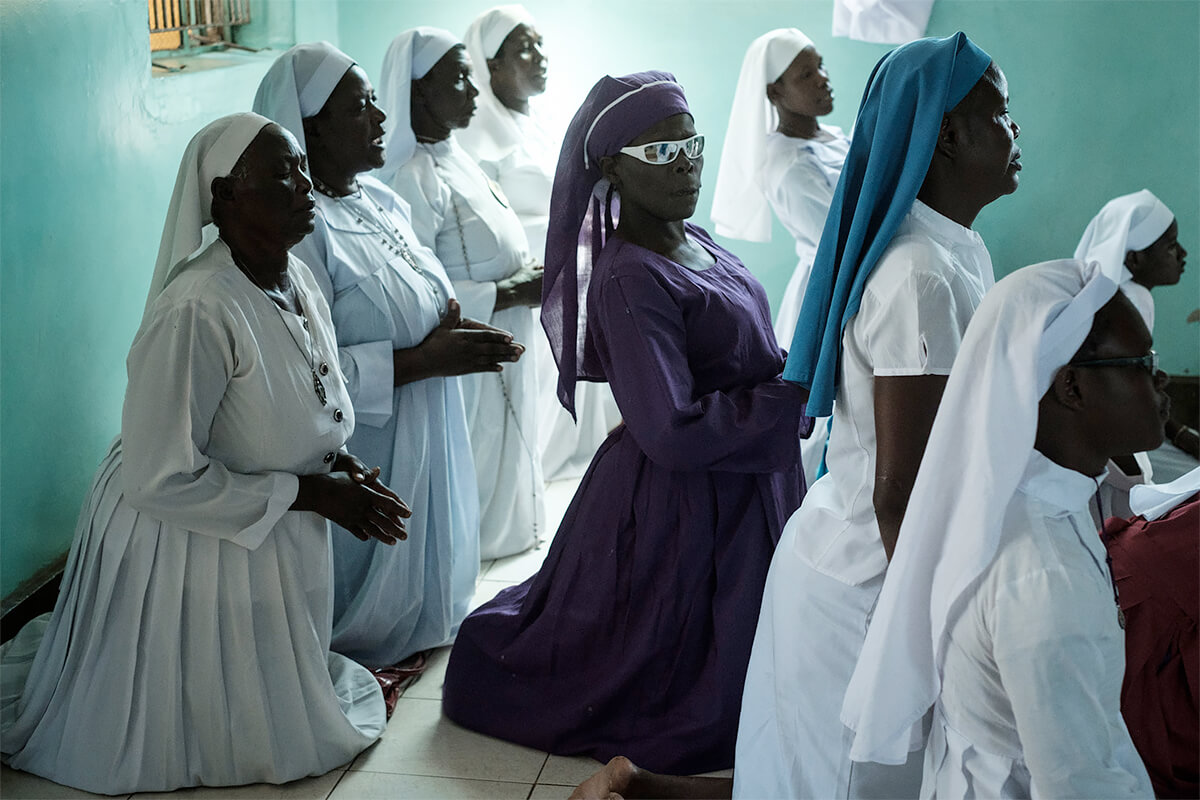
Sunday mass at Saint Mary's Mission church. Kisumu, Kenya, October 29, 2017.
A visit to a home center in Tokyo, where I lives, is to fully immerse in the spectrum of plastics: carbon-fiber this, Teflon that, shelves full of plastic artificial turf, plastic faux-wood floors, shiny-plastic rice cookers and coffee makers, plastic plants in plastic pots; shampoo, soap, skin lotions and make-up packaged in every color of the plastic rainbow. Even 60% of our clothes are made from synthetic fibers (plastic): aisle upon aisle of cheap, polyester, Lycra and acrylic clothing, spanning all age groups from cradle to grave, hanging on racks in neat rows. Finally, consumers wait patiently in line, pushing plastic shopping carts, preparing to pile their purchases onto a plastic conveyor belt, to be scanned by a clerk into a plastic-encased cash register, paid for with a plastic credit card, before stuffing it all into single-use plastic bags to be carried home. Now, after decades of overuse of single-use plastic, the planet is literally drowning in the plastic we have thrown away. By 2017, the world had produced a grand total of 8.3 billion metric tons of plastic, more than one ton for every person on the planet. Most of it, 6.3 billion metric tons, can be found in landfill sites, but another 8 million metric tons of plastic enters our oceans each year because roughly two billion people live within 30 miles (48 kilometers) of the sea. Plastic is literally in every corner of the planet. In 2019, researchers found microplastic in Arctic ice in greater concentrations than in the surrounding Arctic Ocean waters. The same year, explorers found plastic in the Marianas Trench in the Pacific, the deepest point on the planet. Forty-six percent of the mass of the Great Pacific Garbage Patch is made up of ghost plastic fishing nets lost by fishermen. Plastic breaks into smaller and smaller pieces - of plastic - and zooplankton, minute organisms that form the very foundation of the marine food chain, ingest these microparticles, absorbing toxins and less nutrient-rich food. The toxins are then passed up the food chain by predators, and accumulate, most affecting those at the top of the fish-consuming chain, for example sharks, toothed whales, seals, seabirds, and us. According to an Australian study in 2015, 90% of seabirds ingest plastic. Some seabirds have been found with so much plastic stuck in their stomachs that there was no room left for food. Slowly they starve.This series explores the environmental plague of plastic waste that bears down hardest on the developing world, but the challenge of plastic waste disposal spares no country.
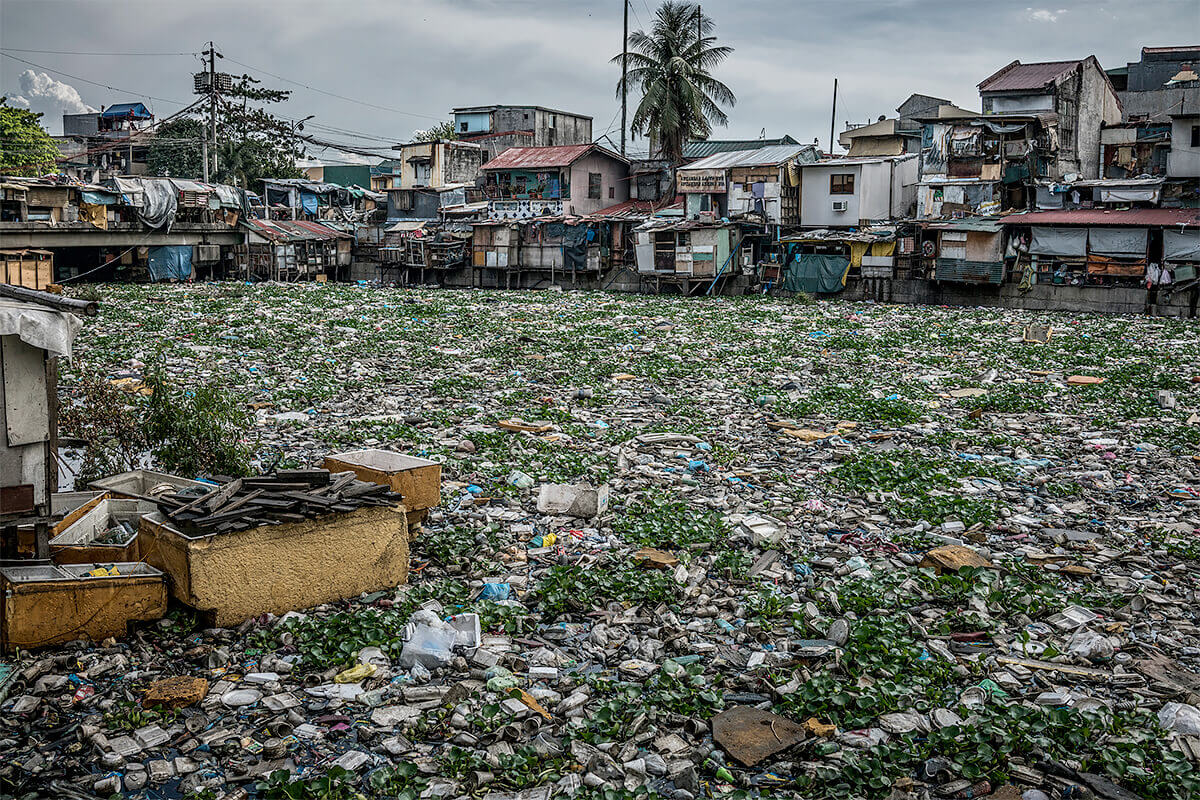
Plastic, water hyacinths and garbage covering the surface of the water of the Estero de Vitas River will be dumped in the Manila Bay, a few kilometers away, and then into the South China Sea. Tondo, Manila, Philippines.
The monsoon is central to Indian life and lore. It turns up in ancient Sanskrit poetry and in Bollywood films. It shapes the fortunes of millions of farmers who rely on the rains to nourish their fields. It governs what we eat. It even has its own music.Climate change is now messing with the monsoon, making seasonal rains more intense and less predictable. Worse, decades of short-sighted government policies are leaving millions of Indians defenseless in the age of climate disruptions – especially the poor.
Water being water, people settle for what they can find. In a parched village on the eastern plains, they gather around a shallow, fetid stream because that is all there is. In Delhi, they worship in a river they hold sacred, even when it is covered in toxic foam from industrial runoff. In Chennai, where kitchen taps have been dry for months, women sprint downstairs with colorful plastic pots when they hear a water truck screech to a halt on their block.The rains are more erratic today. There is no telling when they might start, nor how late they might stay. In 2019, India experienced its wettest September in a century; more than 1,600 people were killed by floods; and even by the time traditional harvest festivals rolled around in October, parts of the country remained inundated.
Even more troubling, extreme rainfall is more common and more extreme. Over the last century, the number of days with very heavy rains has increased, with longer dry spells stretching out in between. Less common are the sure and steady rains that can reliably penetrate the soil. This is ruinous for a country that gets the vast share of its water from the clouds.
The problem is especially acute across the largely poor central belt of India, stretching from western Maharashtra State to the Bay of Bengal in the east. According to a recent scientific paper, over the last seventy years, extreme rainfall events in the region have increased threefold, while total annual rainfall has measurably declined.
India's insurance policy against droughts, the Himalayas, is at risk too. The majestic mountains could lose a third of their ice by the end of the century if greenhouse gas emissions continue to rise at the present rate.
But, as scientists are quick to point out, climate change is not the only culprit to blame for India's water woes. Decades of greed and mismanagement are far more culpable. The lush forests that help to hold the rains continue to be cleared. Developers are given the green light to pave over creeks and lakes. Government subsidies encourage the over-extraction of groundwater.
The future is ominous for India's 1.3 billion people. The World Bank estimates that by 2050, erratic rainfall, combined with rising temperatures, will lower the living standards of nearly half the country's population.In the words of Raghu Murtugudde, an atmospheric scientist at the University of Maryland (USA),
global warming has destroyed the concept of the monsoon... We have to throw away the prose and poetry written over millennia and start writing new ones.
Somini Sengupta
The New York Times, India's Ominous Future: Too little water, or far too much' by Bryan Denton and Somini Sengupta (November 25, 2019)
The water has dried, leaving only the cracked earth. Locals say that a few generations ago, with steady monsoon rains, the ecology of the area was very different. Charam, Uttar Pradesh, India, June, 2019.
Cuba, a tropical island, and a Communist state. In this socialist paradise in the Caribbean, water is of critical importance for citizens. In 2019, the New Constitution of Cuba acclaimed, in Article 76, the right to water, and the responsibility of the state to provide drinking quality water and sanitation. But the ideal of access to water for all is hindered by the daily reality that brings a multiplicity of challenges. With population growth and the effects of climate change, the island's rainwater and groundwater resources can no longer provide sufficient fresh water. The situation in Cuba is unique as the effects of the water shortage are compounded by more than sixty years of Communism. Aging infrastructure is in poor condition causing more than half the water supply to be lost to leakage, and rehabilitation campaigns are frustrated by the United States embargo. These are the main factors contributing to water supply problems encountered on a daily basis. Most cities in Cuba cannot operate a steady water supply, so water is rationed, running through leaking pipes for only a few hours a day. In the city of Trinidad, the aqueduct cannot handle the volume of water, and when water is running, it is pumped and stored on the roof, which is a challenge given the limited water pressure. Confronting these difficulties in a non-automated, non-digitalized society is an army of workers who are sent out onto the streets every day to provide the people of Cuba with drinking quality water. The report presents the challenges and solutions: tanker truck drivers delivering water in districts with no water supply system, health inspectors checking the state of water tanks, and fumigators targeting mosquitos and other insects to help control vector-borne diseases. The report Manifiesto del Agua shows the system as it is - informal - and the inventiveness of the Cuban people in their daily struggle for water. By tracking water across the island, we can gain a deeper understanding of Cuban society, and deeper insights into Communist Cuba as it is today.
The project has been made possible with the support of the Dutch Fund for Special Journalistic Projects (FBJP) and the Anna Cornelis Fund for Documentary Photography. Special thanks to Tanya Habjouqa, Lars Boering and Niels Coppes.
In the event of broken water mains or low water pressure, and in areas where no supply facilities have been installed, delivery trucks known as “pipas” deliver the water. In this neighborhood on the outskirts of the city, residents fill their buckets at the truck that comes by twice a week. Cárdenas, January 16, 2020.
If your subject is scared of you, then your images will reflect their fear, they will not be a true representation of the human or animal. Most of the imagery of wild wolves depicts them afraid and at a distance. But not in the high Arctic with this family of Arctic wolves - unafraid. The project shows the viewer an intimate portrayal of a family in the wild, their hearts beating, and against a background of climate change.I spent over a year trying to document the natural behaviors of wolves in Yellowstone National Park, the best place in the world for thousands of people to see wolves in the wild every year. But the wolves in Yellowstone are still hunted and trapped outside the Park, so are still afraid of humans, as they should be. I came out of the National geographic project feeling that the images I made were not a fair portrayal of the wild gray wolf. It is the challenge of all social documentary and wildlife photographers to create images of their subjects that are intrinsically honest. As modern humans, we are so far removed from the day-to-day lives of wild animals. They speak a language of their own, and they live out their lives often hidden from our eyes. As humans, we try to oversimplify what we cannot understand. We routinely do it with human cultures, and we most certainly apply the same measure to wild animals. These images are an attempt to portray wild wolves using the same approach as a social documentary photographer would for human subjects. With intimate distance and time, the images will come.
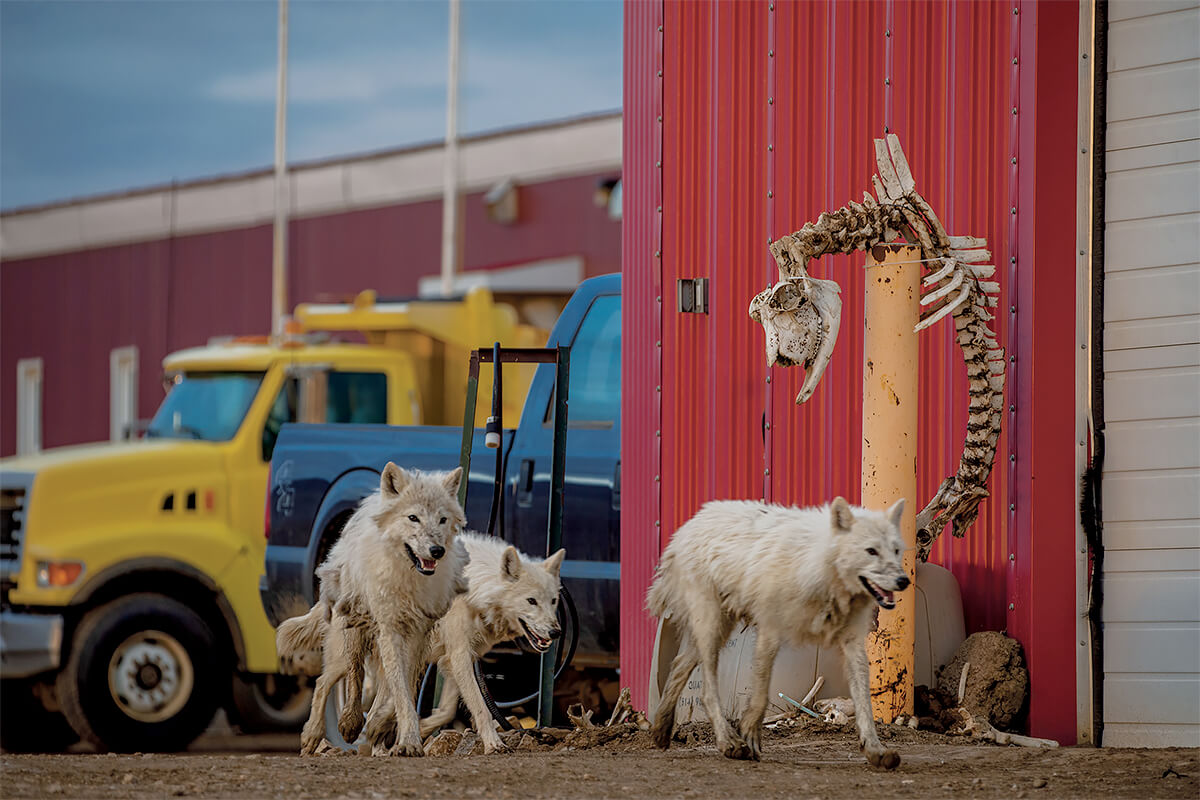
The wolves show no interest in the muskox skeleton as they enter a Canadian military outpost – proof that wolves here do not fear humans
January 2020. It turned out that my Iraqi friends were wrong. That was my first thought when I got back to Baghdad after a few weeks away. For years, they had only had one way of talking about the future: There is no future here, no hope, and no prospect of things ever changing. But the current situation now seems to be proving them wrong. In October 2019, a popular uprising by civil society emerged in protest against the government; as the protesters say it is the thawra, the revolution. It is quite extraordinary for this to have occurred at a time when society seemed numbed by years or rather decades of violence: dictatorship, invasion, civil war, terrorist attacks, kidnappings, lies, corruption, and oppression, all in the name of the State or religion.The movement had been going on for nearly a hundred days, and it was not just a matter of protesting against a government, a Prime Minister or a situation at a specific point in time, but rather an attempt to bring down a dysfunctional and corrupt system, rotten from within, attacked by the gangrene of interference by foreign powers.The protesters were, of course, up against a system that had no intention of yielding. The crackdown was relentless, day after day, with men in uniform, some wielding tear gas canisters used as grenades that pierced the skulls of protesters. According to Amnesty International, by January 2020, the crackdown had left more than 600 dead across the country. Most of the victims were young men, very young men, from poor backgrounds, for it was the poor who were rebelling. This is the generation that grew up with tales of the American invasion in 2003, followed by the civil war, and then ISIS. Their had no prospects, just a society at a standstill, with no properly functioning public services and endemic unemployment, a society stricken with fear, divided between different communities, with crass nepotism prevailing. They say they have nothing more to lose, stating, with apparent sincerity, that they are willing to die. Alas, they have sometimes been proven right. Their revolution seems dreadfully ingenuous. There on the banks of the Tigris, the T walls epitomizing the fear of terrorist attacks have been painted in every color of the rainbow. On Tahrir Square, rebels have set aside their Molotov cocktails to feed stray dogs.Some have no delusions about the future of the movement: Just look at the revolutions in egypt or Syria, and the way they turned out, said one young man. But these past months, weeks or days of freedom are still steps forward. Hours spent painting the T-walls pink offered a glimmer of hope, the prospect of a different society, a different future. But can prospects alone bring about change?I think of a twenty-year-old friend named Abbas who turned to me and said, coldly, bluntly: iraq is the land of death. There is no prospect of any future. Today, for the first time since I came to know Iraq, I have the impression that grim resignation and acceptance of death have faded and been replaced by rage, and hope. I hope that Abbas, too, can be proven wrong.
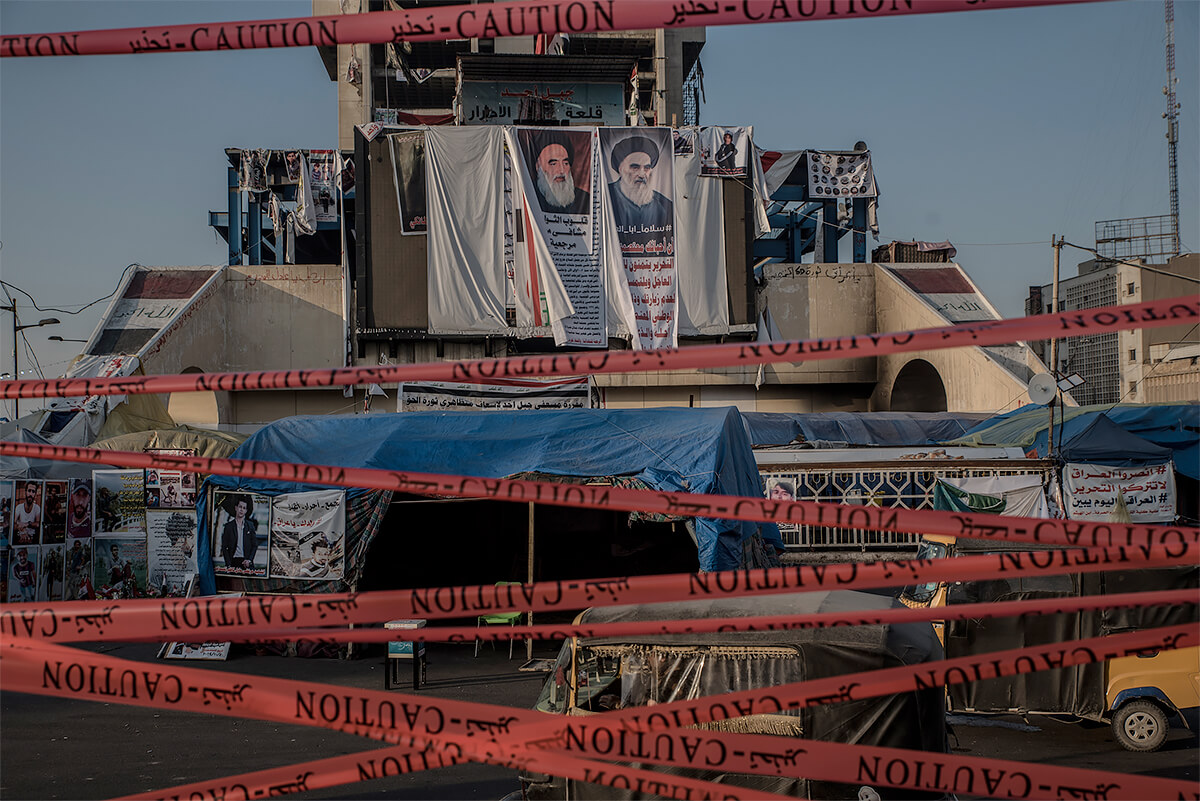
On the wall of the “Turkish restaurant” building are portraits of Ayatollah Khomeini (right) and Ayatollah Ali al-Sistani, the senior spiritual leader of Shia Muslims in Iraq. Baghdad, January 17, 2020.
Xapiri indigenous gods had foreseen the environmental tragedy that struck Brazil in 2019 when humans destroyed a total of 9,762 square kilometers of Amazon rainforest, an area as large as Lebanon. This set a record for deforestation: an increase of 29.5% on the previous year, shocking the international community and triggering protests across the world, with Greta Thunberg speaking out and demanding urgent measures.Why should we conserve forestland? We are experiencing a climate emergency, and the loss of the tropical rainforest could mean a further increase in greenhouse gas emissions causing climate change. The land use model in the Amazon and other tropical rainforests around the world, cutting down trees to clear land for non-sustainable use, has brought the worst impact of global warming upon us. The selection of images presented here is an overview of the Brazilian Amazon in 2019, showing deforestation carried out by persons illegally occupying untitled land. The photographs were taken over a period of 70 days which I spent immersed in different parts of the Brazilian Amazon, reporting for The New York Times. This is an investigative project designed to give a deeper understanding of the social and environmental relations inside the forest where illegal occupation of land is prevalent.The expansion of farmland for livestock is the main factor in the destruction of the forest, and is backed by powerful politicians in Brazil’s National Congress. There are also illegal mining activities, supported by President Bolsonaro who has presented draft legislation to allow mining and hydroelectricity operations on indigenous land.Predatory logging is the first step in a complex network of illegal operations: felling trees, then selling and exporting them with false documents. The process known as esquentar madeira consists of recording timber taken illegally from protected areas as wood from legally felled trees prepared ready for shipment. How can the process of destruction under way, and backed by the Brazilian government, be stopped? My ambition is for my photographs to have an impact on the general public, triggering a reaction so that we can force the authorities and companies to take action and implement proper sustainable forest management. With the knowledge of the forest-dwelling communities and with contributions from science based on the concept of the green economy, we could find satisfactory ways of reversing this situation of climate emergency. The challenge is here. It is time to act!
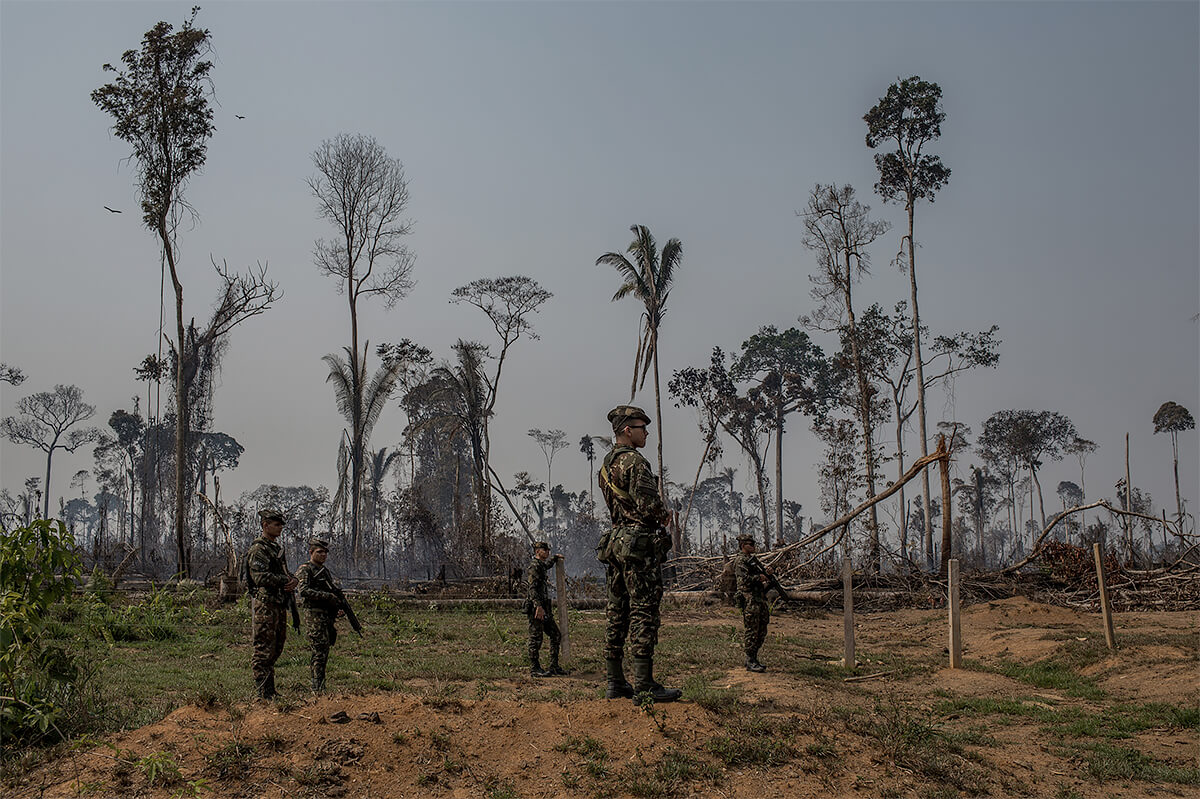
Soldiers provide security for firefighters. During fires, henchmen acting on orders from farmers attempt to intimidate firefighters and rangers.
After being in prison, women find themselves living on the fringe of mainstream society. According to official figures for France, in October 2019, the country had 2,485 female detainees, 3.5% of all prisoners. They may be a small proportion, but that does not mean their prison conditions are better than for men. They invariably end up being isolated, far from family, friends and their own social networks. In October 2017, I spent two weeks at the women's wing of the jail in Joux-la-Ville where I was doing a photo coverage of the shooting of a film which had eleven of the inmates acting in it. Gradually we developed a bond, and the women opened up to me. There was Magalie, Adeline, Rahmouna, Laura and others; they were all coming to the end of their sentences, and were all on edge. For years they had had no contact with their families, and while they were obviously looking forward to getting out, they were also very scared. We agreed to meet up again on the outside. It was difficult to stay in touch, but we sent letters and text messages. Some of them called me when they got out; others called months later. Four of them agreed to let me go around with them in their daily routine. We met up, often spending a lot of time together. Magalie, Adeline, Rahmouna, and Laura are women whose lives have been shattered, destroyed, first by violence, and then by a prison system totally unsuited to them.France has only five prisons with female inmates, and four of them are in the north of the country, often hundreds of kilometers from their homes. The women have very few visitors, and are ostracized and stigmatized both on the inside and the outside. Almost all female prisoners in France have been victims of violence (ref: ENVEFF study, 2003), and 13% of them are illiterate. In prison, they are numbed, dulled by excessive use of medication, often as substitution therapy. By the time they leave, many are addicted to substitute drugs or tranquillizers. With little or no support after they are released, 65% of the women end up back in prison within five years. These are women with no self-confidence, who have been made even more vulnerable through the experience of prison. The challenge of rehabilitation and returning to mainstream society is an apparently endless series of ordeals as they battle with bureaucratic procedures, and face stigma and loneliness.
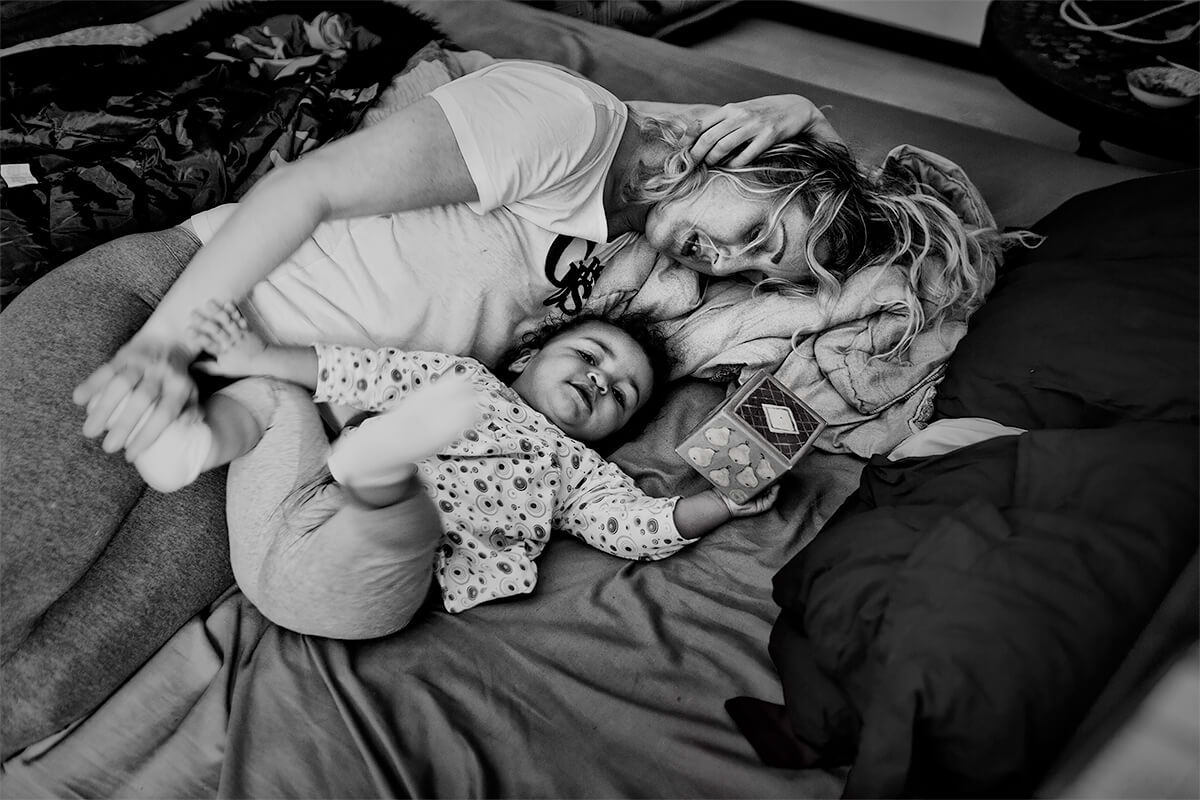
© Axelle de Russé/Hans Lucas
Adeline gazes lovingly at her daughter Charlie. She did not lose custody of the child and is ready to start life over again. Troyes, France, November 2019.
In May 2019, a scandal erupted in India when NGOs released alarming evidence showing that every year thousands of women working on sugar plantations in the state of Maharashtra are victims of unnecessary hysterectomies.The practice began in the 1990s and developed as a profit-making venture for private doctors who, when consulted for routine conditions, led patients to believe that they needed to have their uterus removed. The doctors played on the women's ignorance of their own bodies, carried out the surgery as if on a production line, and did so with total impunity. As they operated in private clinics, they were free to set their fees, which could reach amounts of more than 600 euros, an absolute fortune for the women. Previously, until the 1970s, abortion had been the most lucrative practice for such doctors, but with easier access to contraception and sterilization, they had to find other sources of income.The women working on the sugarcane plantations are a perfect target: their labor is part of the country's informal economy, and working conditions are therefore not covered by legal provisions or trade unions, and the women are not entitled to social or health insurance. As the physical labor on cane fields is particularly arduous, it can lead to health problems causing the women to seek assistance from these dishonest doctors. And their suffering does not stop there, for many of the bosses on the plantations (the “mukadams”) urge the women to have hysterectomies to stop their menstrual periods and thus increase labor productivity. Such abusive practices are part of a more general trend towards privatization of the Indian economy and the quest for greater profit. After the latest revelations, the government set up a committee in June 2019 to investigate the practice in the district of Beed (Maharashtra), in the region which provides most of the labor for the country's sugarcane plantations. The dire poverty of the people there means they have no other choice than to accept jobs as cane-cutters, despite the poor working conditions with no job security or guaranteed income.To date the committee has issued only guidelines, and no concrete measures or sanctions have been instituted. For NGOs, the culprit is the private medical sector, but the government has chosen to look elsewhere, which means there is little likelihood of any change occurring for women whose bodies are being butchered for the sake of profit.
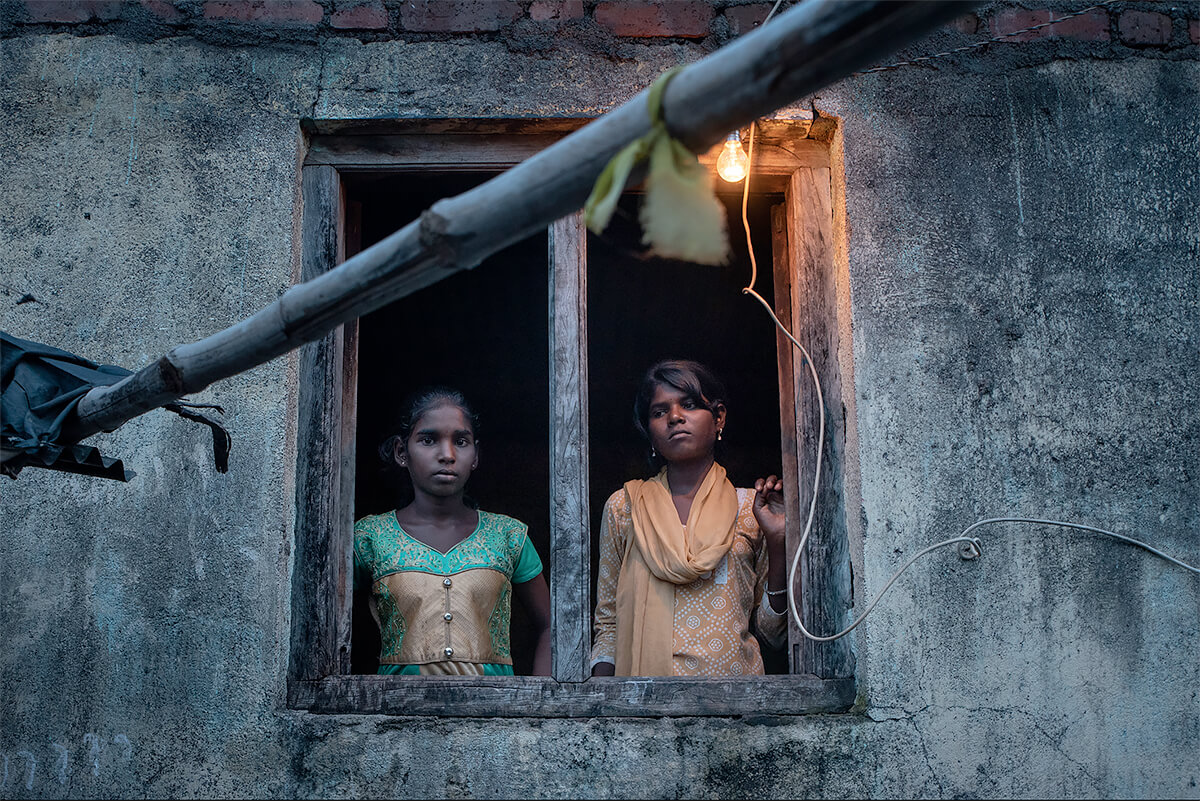
© Chloe Sharrock/Le Pictorium
These two teenage girls will be traveling south to help their mother working on a sugar plantation. Four years ago she had a hysterectomy and is in such poor health that her daughters now have to leave school to help her. Kasari/Bodkha, Beed district, Maharashtra, India.
Since June 2019, protests have rocked the city of Hong Kong. What began as a movement against draft legislation allowing Hong Kong residents to be extradited to mainland China to stand trial, became an overwhelming indicator of growing discontent with the Chinese Communist Party. Millions took to the streets in mostly peaceful pro-democracy demonstrations, but over time protestors became more radical as the government toughened its position. To date, over 7,000 people have been arrested, 2,600 have been injured and there have been two related deaths. Protests that were originally political have developed into something quite different, addressing long-standing social grievances in Hong Kong, including the widening gap between rich and poor, the lack of affordable housing, the steady erosion of rights within the territory of Hong Kong, and increasing animosity between mainland Chinese and locals who now see themselves as distinct, as Hong Kongers holding out against the inevitable stranglehold and control by the central Chinese government. The principle of governance of one country, two systems (introduced in 1997 when Hong Kong was handed over to China, ending 156 years of British colonial rule) will end in 2047, but critics argue that the deadline has already been reached, citing many instances where China has sought to erode the special freedoms and status of Hong Kong, to assert greater control over the territory, and to silence dissenters. I had spent nearly ten years covering the Middle East before returning to Hong Kong to document the protests, and was surprised to see how quickly demonstrations had become the new normal. The city was transformed, with people taking different sides over multiple divisions: some supporting the protestors, others despairing at the chaos, and some backing the crackdown by Beijing. The place of my childhood had descended into an unfamiliar rhythm, and seemed to be almost accustomed to the extreme violence. The People Dissent is about the hope of young protestors living and continuing to live in hope despite increasingly bleak prospects for the political future of Hong Kong. Complexities behind the demonstrations go deeper than visual observations. This David and Goliath showdown is, according to most observers, destined to fail, yet, in spite of everything, the protestors are persisting. They have no future to lose. They dissent, against the Chinese government and its proxies, and against what seems to be an inevitable outcome.
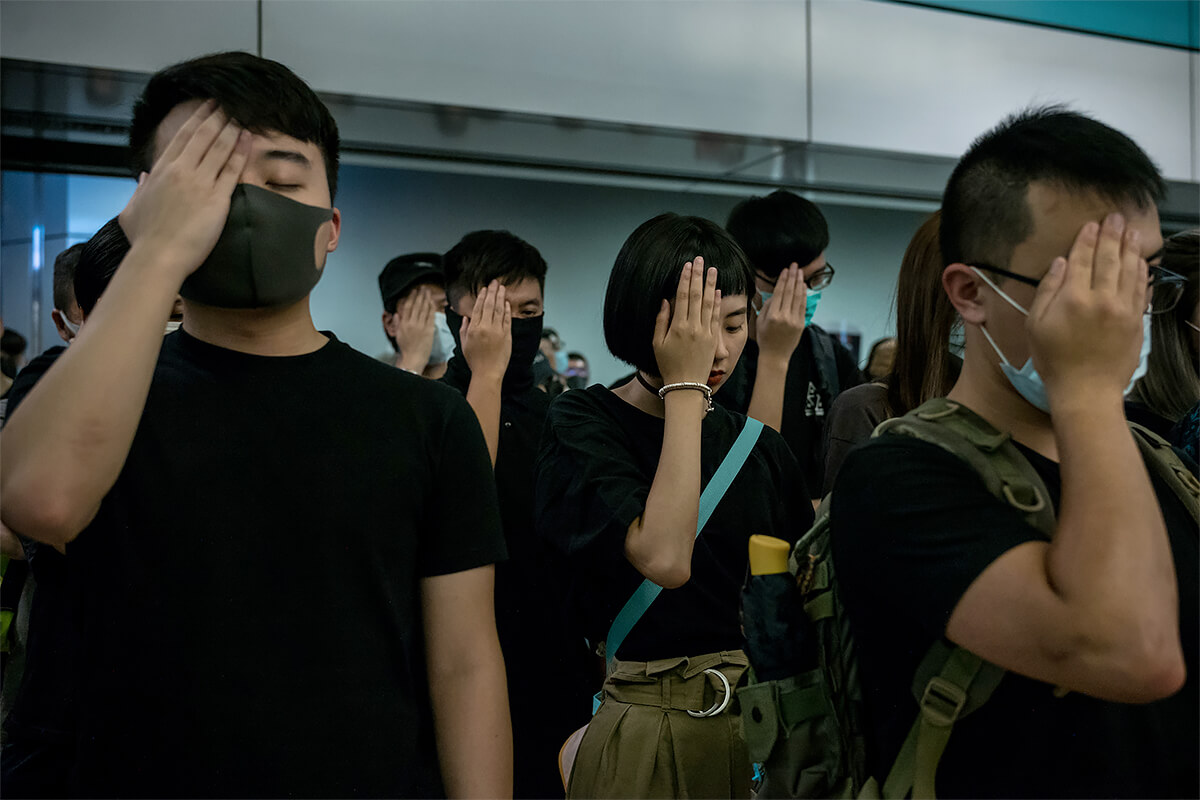
Protestors covering their right eyes in solidarity with a female medic who was shot in the eye by police earlier in the month. Hong Kong, SAR, August 21, 2019.
Here is a visual tribute to the humanity of the heroes and victims, often one and the same, who have been at the New York City epicenter of the war against the Covid-19 invisible enemy over the past two months.As a documentary photographer, over the past forty years I have covered so many major news stories of geopolitical importance, including most wars and conflicts. I have been a nomad over those four decades, rarely spending more than two or three weeks in one place, then, in March, I found myself in New York City when the Covid-19 lockdown was imposed, and I was unable to travel. On the first day of lockdown, I did what was most natural to me: I went out into the city with my camera. I was stunned and shaken by what I saw. I realized that this was the first time I was going to witness a war on an invisible enemy at home. It became clear that this was going to impact every single person, that every person had a story. I immediately began a daily New York lockdown visual diary. I go out almost every day with my camera and notebook, wearing a mask and gloves, keeping a careful distance from everyone, and I return to where I am staying, alone. I have felt that it is essential to document the human stories of the moment, the stories of the people I encounter, and these in turn are also, in part, our story. The documentation has been personal. I have kept the visual diary published almost every day on social media, and receiving responses worldwide. Ironically, while this has not been part of a professional assignment, in many ways everything that has preceded, in the 64 years of my life and as a photojournalist, has prepared me to be present and document, with my heart, what has been for so many of us, a most important story in our lives. At this moment in our life, it is essential that the stories of so many heroes and victims, of all dimensions, be documented, helping bring us together now, and for memory.New York City, one of the epicenters of the coronavirus, is a city of human beings, each with a name and age, each with a life experience, each with a family, and all, like every one of us, more important than any statistics, peaks or flattened curves. They are the heart and soul of this moment, and the heart and soul of our moment. While these images and stories are from New York, they are in solidarity with every country in the world and every person in the world, all fighting against an invisible enemy. Our human family worldwide has found itself in the middle of the crisis. This visual diary is also our story.
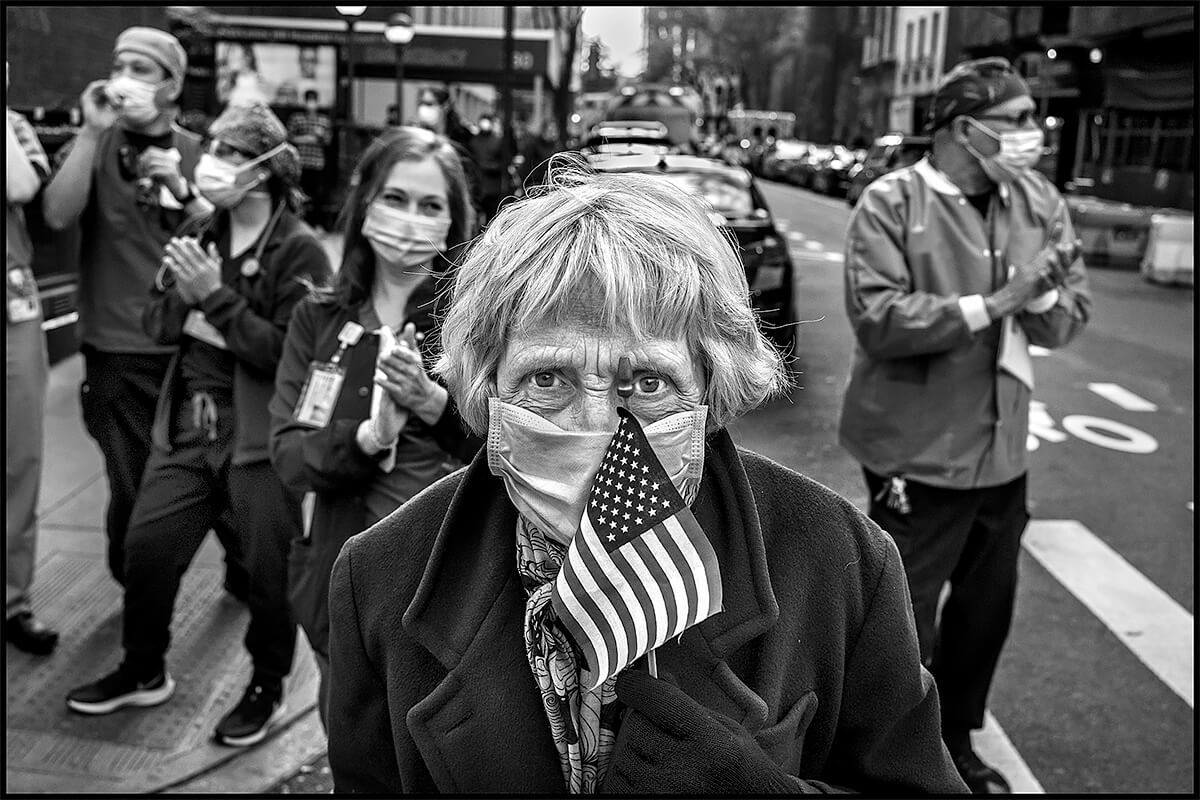
Each night, at the corner of 77th and Lexington at 7pm, the healthcare workers at Lenox Hill Hospital come outside, and local residents express their gratitude. I have seen the woman in the photograph (Nora) every time. Usually she does not want to be photographed, but this time she stopped to look me and my camera in the eye for a good while. Certain expressions and people embody the mood of a moment. Here Nora’s eyes spoke for all of us: confused fear and hope for our future, for our health and survival, while ready to engage in the present so as to reach the future.
By the time the Hong Kong protests started last year, I had been AFP's Hong Kong bureau chief photographer for three and half years. Before this, I was working as a photo editor on the Asia-Pacific photo desk, also in Hong Kong, with some photo assignments to support my predecessor. And I was also one of the backup shooters during the 2014 Umbrella Movement mass demonstrations.My own bureau coverage would generally involve a lot of walking around the city, producing daily life photos, working with my colleagues on visually rich local feature stories, and taking portraits during interviews and press conferences. I would also cover street rallies, like the annual July 1 march when the city marks the handover from the United Kingdom to China, or on China's National Day, October 1. I was constantly busy, but my most challenging assignments were when I was sent on AFP missions overseas. In Hong Kong, on Sunday June 9, 2019, when people marched against the draft extradition bill it took everyone by surprise, but there was no immediate indication that it would turn into anything like the 2014 demonstrations. I came back from my annual holiday the day after the demonstration and when I asked colleagues if they thought something similar would happen in the following days, they said probably not. Although protests continued to flare here and there, there was no real sign of what was to come.On June 12, I was on my way downtown, tired after a few hours of sleep. As I walked out of the Admiralty metro station, near the Central Government Complex, my jaw dropped.A sea of people filled the streets in scenes similar to 2014. People were clambering over the concrete barriers separating pedestrians and traffic. I just stared at the scene, not knowing where or how to start covering such a huge story unfolding. I sprang into action. Someone helped me climb onto the barrier where I took my first photos, then sent them to my photo editor colleagues who quickly validated them. My boss called, asking if everything was okay, and telling me he had organized for another AFP photographer to fly in and back me up. Suddenly, Hong Kong had become the main global news story and I would have to learn to coordinate a photo team and keep pressing on with the coverage.Later that day, I experienced tear gas for the first time. It scared me when I heard the sound of tear gas being fired, and I didn't know where to go. Even though AFP had provided me with conflict training and the best protective equipment, I felt clumsy as I quickly put on my gas mask and helmet. I ran over to a wall to keep away from objects being thrown by protesters and from tear gas canisters. I knew I had to pluck up the courage to move away from that wall and photograph what felt like chaos. In the weeks and months that followed, scenes like these became commonplace and things got more violent and intense. AFP photographers from the Asia-Pacific region were flown in to provide vital backup. I also had AFP photo editors and Hong Kong-based freelance photographers who were on the ground with me from day one, so sometimes I could take time off with my family. Often I would spend the night away from home, in a hotel or whatever I could find, to ensure we had 24-hour coverage. I would then return home to try and be a normal parent for my two young kids, and a husband for my wife. At times it felt like a dual existence.I dedicate this award to my Hong Kong bureau colleagues, my photo team, the AFP photo editors, and my dear family and friends, who have all supported me during this often challenging and ongoing coverage.
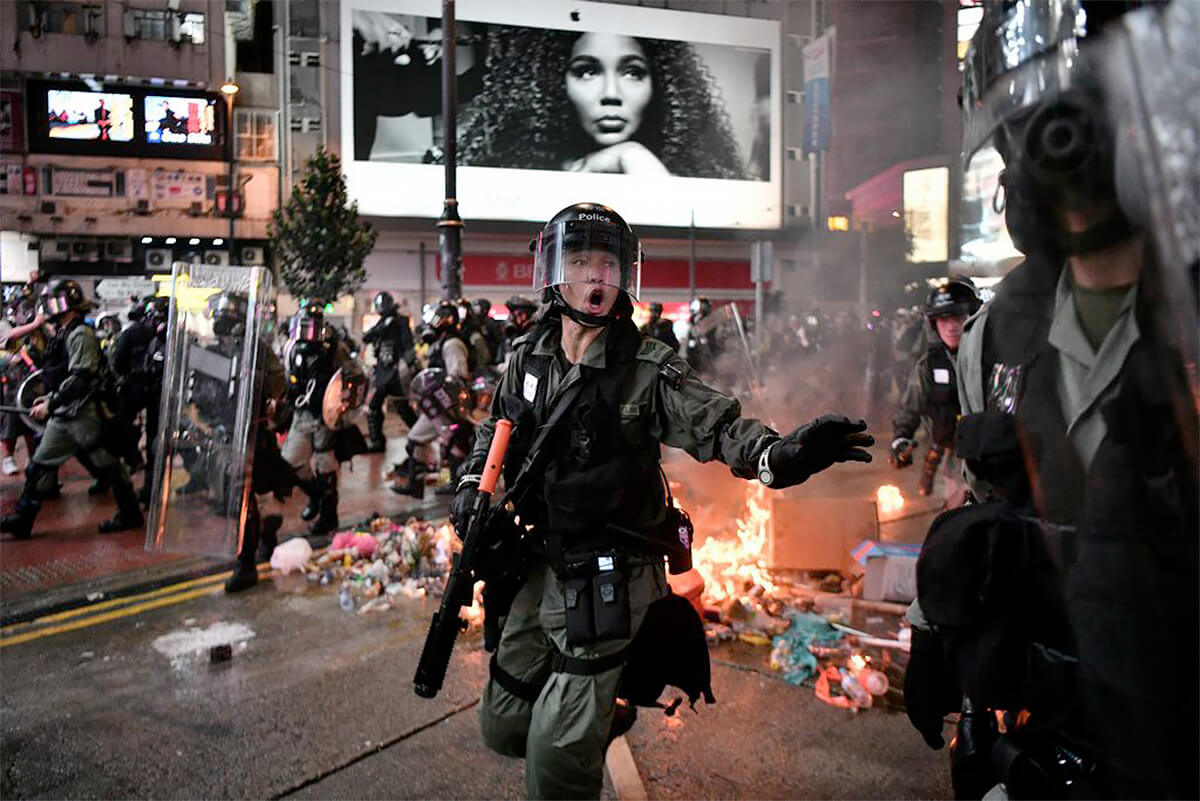
Police run past debris set alight by protesters defying a ban on rallying, and mounting threats from China, to take to the streets for the 13th straight weekend. Causeway Bay area, Hong Kong, August 31, 2019.
as Long as the Sun Shines explores the intersection of climate change and the legacy of settler colonialism on which Canada was founded. The colonization of the Indigenous peoples of Canada is usually seen as an event that occurred centuries ago, and is incorrectly contextualized in a past no longer related to our future. The truth is that Canada's slow-motion cultural genocide still lives on in the form of environmental racism. Industrial development of Indigenous territories, disguised as economic opportunity, has inflicted ecological damage on communities across Canada. After centuries of oppression, most of Canada's First Nations are financially dependent on the federal government and suffer from multiple and inter-related social issues. The capacity of First Nations to stand up to industry is limited, and the legal system is biased against them. Communities which cooperate with industry receive economic benefits and greater powers to protect specific slivers of their territory. But the trade-off is bitter and far-reaching. This project zooms in on this destruction as experienced at a daily and intimate level, destruction occurring in the shadow of an industry so large it can be seen from space.On reserves across Canada, widespread ecological damage and contamination make it impossible for Indigenous peoples to live off the land and achieve a sustainable livelihood in environments that have nurtured their lives for centuries. Cancer clusters, rare cancers, birth defects, lupus and other health problems occur at alarmingly high rates. Intense forest fires, driven by climate change, devastate land not yet impacted by industrial development. The Canadian oil sands are the largest, most environmentally destructive oil development on Earth, and the industry is often cited in the global battle on climate change. Infrastructure for the extraction of oil sands stretches across Canada, affecting hundreds of Indigenous communities. With traditional economies of hunting and fishing now decimated, members of First Nation communities have no other option but to work for the very industries that are destroying their land and culture. In Fort Chipewyan, locals describe this process as slow-motion cultural genocide, while the nearby oil industry city of Fort McMurray has benefited from decades of exceptional economic growth.Ecological destruction is now deepening racial and economic wounds within contemporary society, thus perpetuating old systems of assimilation through dominance.

© Ian Willms/Panos Pictures
An Imperial Oil refinery near Aamjiwnaang in the “Chemical Valley,” an area of 39 km² containing 40% of Canada's petrochemical industry.
